Home >
Mashonaland West >
Thomas Baines journey to present-day Mashonaland: His second journey described from 16 May to 30 October 1871 (Vol 3)
Thomas Baines journey to present-day Mashonaland: His second journey described from 16 May to 30 October 1871 (Vol 3)
Introduction
This synopsis is taken from The Northern Goldfields Diaries of Thomas Baines (1869 – 1972) Volume 3 edited by J.P.R. Wallis. Note I have generally given Baines’ spelling first followed by later and present-day spellings in brackets. I have ended the diary entries on 30 October when Baines and his companions cross the Limpopo river although Wallis continues the journey as far as Pietermaritzburg that was reached on 13 March 1872. There are notes on the actual diaries in the article on Vol 1 of Thomas Baines diaries.
May 1871
16-May Baines writes that through the kind assistance of friends he was enabled to fit out a new expedition for a journey into the interior. He has employed a white driver named Stephen Gee and a young boy named Maatchen in addition to Robert Jewell who was appointed in London as local secretary of the South African Gold Fields Exploration Company and photographer. They only have 10 oxen for one wagon and 8 for the other – the usual number being 12 for each wagon in South Africa.
He is waiting for a letter from Theophilus Shepstone, Secretary for Native Affairs in Natal addressed to Lobengula to thank him for his friendship and hoping that it will continue. However Baines writes that things are now more complicated as the person who claims to be Kuruman in Natal, Mzilikazi’s heir, at first claimed he was not the heir and so the amaNdebele stopped looking for him and appointed Lobengula as Mzilikazi’s successor.
19-May to 16 July The diary entries relating to the trek from Natal are omitted except for those quoted below that are relevant to the subsequent journey.
No funds have come through from the company. Baines writes on 28-May: “I painted the Portuguese arms on Mr Van Zeller's wagon and his name and title as Consul General. For this he is to give me a sheep and two more for copying my map for him. I am under the necessity of getting provisions of this kind as I can, for I believe Jewell has not about three or four pounds in hand for the expenses of the journey…”
Their few oxen have further casualties on 4-June: “the afternoon we tried to drive England and the other ox onward, but they could not go 100 yards and as the general opinion was that we could do no more, I shot them both and let the people and dogs do as they liked with the meagre flesh.”
South of the Vaal river they had good shooting on 10-June: “We brought the flesh of all three [wildebeest] to the wagons, horses and men being well loaded, and saw a fourth apparently badly wounded. Gee had also shot two wildebeests and had bought one home, so that we now have as much meat as we know what to do with.”
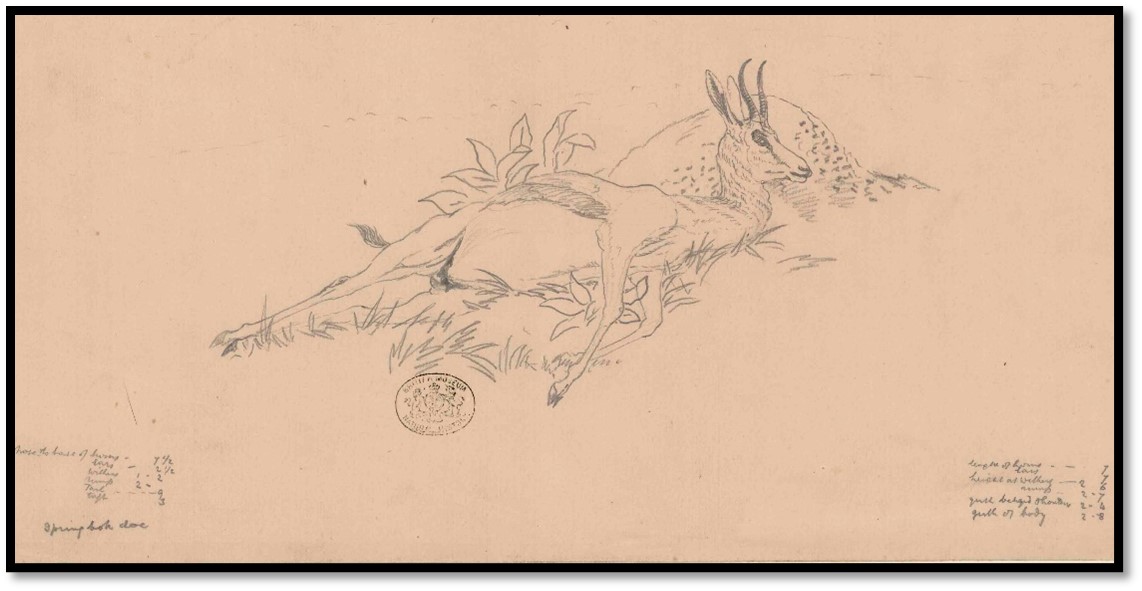
NHM (London) Baines Collection No 141: Springbok doe presumably seen in the southern Transvaal or Cape Colony as they are not found in the northern Transvaal or Natal
On 14-June whilst riding to Potchefstroom for his letters he met Paul Zietsman[i] at the Suikerbosrand hills travelling to his own farm in Natal. Baines writes: “He told me it was reported in the interior that our company had given up its intention of working the goldfields and that I would work them on my own credit. I told him the report was premature for just before I came away from the Natal I had letters to say the company was about to send me machinery…”
By the 17-June Baines was in Potchefstroom and had collected Shepstone’s letter that he was to take to Lobengula. The accompanying letter to Baines had as its central theme: “You are aware that a person calling himself Kuruman and representing himself as being the true heir of the deceased chief Umzeligazi [Mzilikazi] has been living for many years in the colony of Natal and has at length resolved to return to Matabililand (sic) to claim what he avers to be his position by right of birth and the law and customs of the Matabili people. He has been recognised by the eldest son of Umzeligazi [Mangwane] and by other sons also, as the person he represents himself to be and they have officially notified this to the government of this Colony…”
There was also a letter from Karl Mauch complaining that Henry Hartley wished to take credit for the gold discoveries that he stated belonged to himself alone and that that statements critical of Mauch had been made in several newspapers. [as stated in the article covering Volume 2 Henry Hartley did indeed discover both the goldfields at the Bembezana river and at Hartley Hill…Mauch merely confirmed them and gives no credit to anybody else in his own diaries]
Patrick MacGillivray (McGillewie) the elder brother of Henry McGillewie who Baines learnt on 30 July 1870 had died of fever at the Serui river Mashonaland states he is anxious to visit his brother’s grave and Baines suggests that all those who have died should have a memorial to their memory either at Inyati mission or Hartley Hill.[ii]
Also more evidence of the shortage of funds…”I found my hotel bill somewhat more than I could pay owing to the high price of forage – 1/- per bundle – my horse thus costing me 18/-, besides 4/- for medicine, which was more than my own expenses amounted to. Mr Coulson therefore gave me credit for 8/-.”
On 20-June Baines reached the Jennings farm, but Jennings snr was away hunting elephant and the sons were leaving with produce for the diamond fields. At Thorndale farm they found Henry Hartley and his wife had left the day before, but Jewell was just in-spanning at Fred Hartley’s with oxen he had been lent to help him through the poort at Maghalies river. Baines rode over to Thomas Hartley and was sorry to learn he received nothing on the company bill Baines had given him for the purchase of horses. Despite this, Thomas still offered them provisions of salt pork, bacon or ham and Jewell went over to make a choice.
The moon was setting on 23 June over the Pilanesberg and it was getting almost too dark to ride when Baines saw ahead of him the Hartley wagons and campfires. Everyone was asleep, except a pack of fierce watch-dogs who recognised Baines and became quiet but not before waking the Oude Baas who dressed and came out and put some large home-made sausages on the fire. Hartley had given up all hope of seeing Baines as Arkle, the engineer of the London and Limpopo Mining Company had written to say that Baines would not be able to come up. They both regretted that Nelson had joined the same company at Tati and it was said that the Australians at Todd Creek were getting out more gold bearing quartz than could be crushed.
Hartley was pleased with the gun that Baines had bought for £42 for Lobengula and with the letter from Shepstone. He believed that Lobengula would not give up as easily as Shepstone imagined as those that supported Lobengula will fear that if Kuruman becomes king they will all be killed. Hartley believed Baines will have done Lobengula a great service in delivering the letter as he will know for certain that Kuruman is coming.
Hartley also thinks it will be impossible to reach the northern goldfields before the onset of the rainy season in November. Baines agrees but thinks that visiting the king and keeping the company’s interests alive and cheering up the company’s supporters will be worth the time and cost spent on the journey. Hartley intends only going to Tati before returning to the confluence of the Marico and Limpopo rivers as his son and Maloney report that the geological formations there are very similar to those at the diamond fields.
On 30 June at the Groote Marico drift Baines came across the wagons carrying crushing plant for Tati. They used block and tackle to ascend the steep bank, but the stiff rope would not grip and the wagon went down in a rush breaking the leg of one of the oxen and being dragged into the water.
At the Limpopo reached on the 3 July there are some kopjes that are very similar to the diamond kopjes at Hebron and Klipdrift on the Vaal river in Griqualand West. The going becomes hard in heavy brown sand, the wagon wheels sinking 8 inches and sometimes a foot into it and water is scarce so the oxen become exhausted and obstinate. Thirsty individual oxen can become dangerous and charge whenever they are driven on, so often the only recourse is to shoot them for the meat.
They have come across refugees from Matabeleland who supported Kuruman as the rightful king; some have taken refuge with Matjen who employs them as bodyguards. Lobengula sent a demand to Matjen saying they should be killed. Matjen refused and sent a taunting letter saying Umzeligazi was a man but could not take Shoshong and Lobengula, who was but a child, would certainly fail. Lobengula replied saying he was coming with his people and asked the Bamangwato to come out and fight him on the plain and not run like rock-rabbits to the hills.
The Lotsani (Lotsane) river was dry where they crossed it and the situation was getting desperate until Gee found water in a pool just 100 yards from the road.
On 12 July the dogs began barking in front of the wagons, Baines thought it might be a hyena or jackal but a deep growl revealed a lion. Taking his rifle Baines hurried to the sound to hear from Jewell that the dogs had fought with the lion only 5 yards from the oxen and one ox, Spider, had been wounded on the shoulder. The wagons were drawn up and the oxen outspanned and tied to their yokes, fires built up and all became quiet until the lion revisited the camp and was then driven away by one of Hartley’s drivers firing a shot. Jewell’s dog Pickles vanished as did two of Hartley’s dogs and were probably taken by the lion.
18-July 1871 they reach the Tati river. The broad sandy river bed was “destitute of water as the Sahara desert” and Old Tati seemed deserted. The London and Limpopo Mining Company store had been renovated, but the doors were closed and all the settlement’s inhabitants were living in the house built by Kisch high up the hill. Bunting Lodge built by Edward Coward was burnt down, Dr Coverley’s house still stood, but was uninhabited and only Messrs Acutt, Brown, Franklin, Hall and Nelson came out to welcome the arrivals. John Cooksley, who recently brought Nelson from Potchefstroom was about to return the next day. John Lee was at Mangwe.
19-July The bill for £60 given to John Lee as his pay has been passed to Brown who wished to use it for paying the London and Limpopo Mining Company but has been refused by Robert Acutt their storekeeper who has orders not to take any bills from the South African Gold Fields Exploration Company. Baines notes: “though I offered him my own personal guarantee, I cannot in conscience tell him it is of much value and the only thing I can do is let Mr. Acutt have a number of our tired oxen as security until I can hear from home.”
He has spoken to Nelson who is quite obviously reluctant to work for the South African Gold Fields Exploration Company perhaps because he has a better understanding of the precarious financial state of the company’s affairs.
Jewell received the oxen he left with Acutt last year and Gee is training them with a sledge and they are doing well considering they are Mashona pack-oxen.
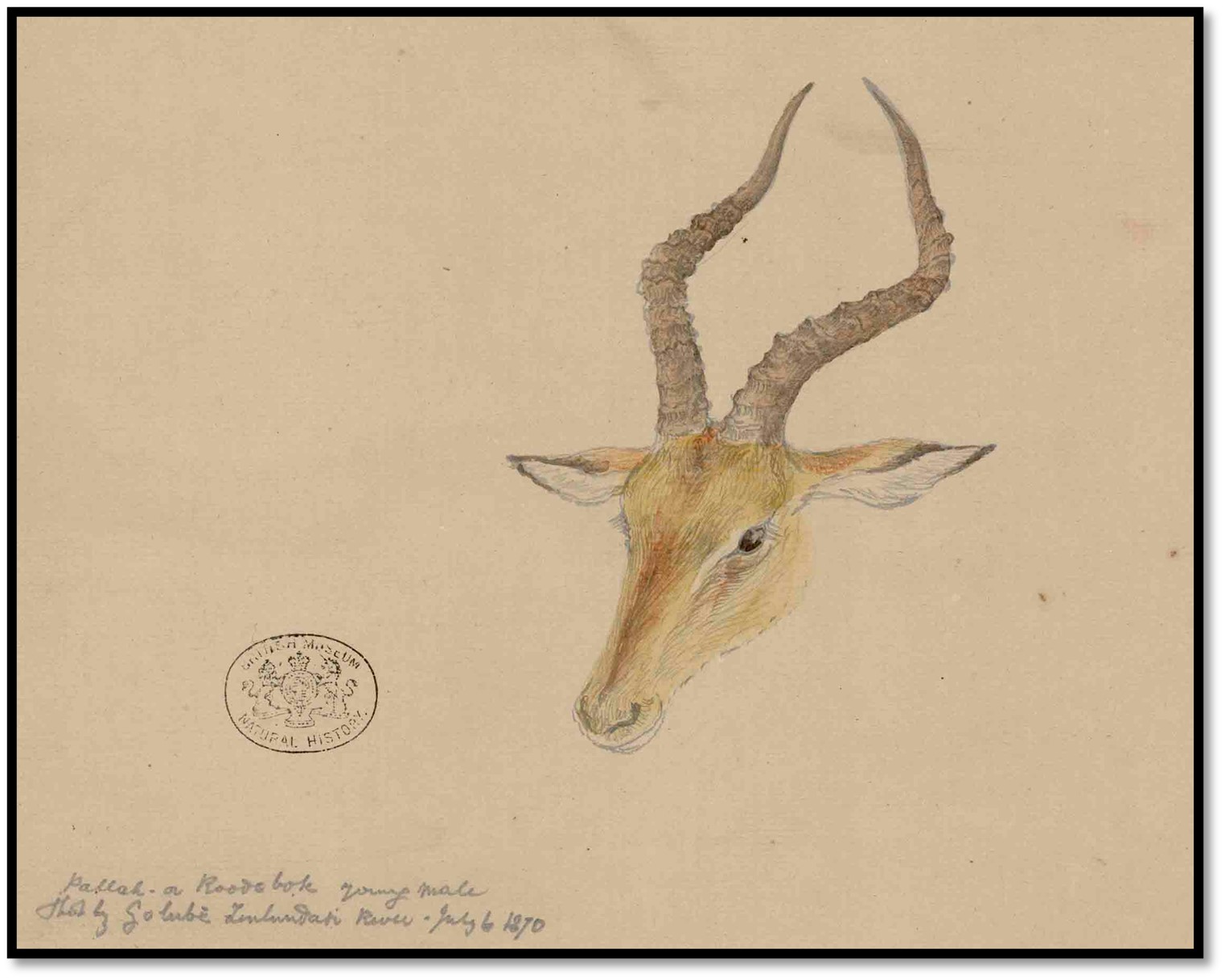
NHM (London) Baines Collection No 137: Young male Pallah (duiker) shot by Golube on 6 July 1870 at the Zinlundusi [Chirundazi] rivulet, a tributary of the Umvuli [Umfuli / Mupfure] river
23-July Greit [August Griete] came in from the Blue Jacket mine 3 miles north-east of Tati and invited Baines to visit. He describes a comfortable little house, goat kraal and storehouse with floor raised 2 feet on posts covered with tin-foil to prevent the rats climbing up. The Blue Jacket shaft is about 80 yards from the house with approximately 180 tons of quartz heaped at its mouth. The original shaft is on the old diggings and a drive at 20 feet meets the old workings. A second shaft has been sunk to 70 feet to intersect the reef that then dips and further development has been halted because of water. The digging of a third shaft has halted because it was feared it may not intersect the reef. The original claim cost Griete £200, he has spent a further £300 on development and extracted £300 worth of gold.
24-July Griete and Baines descend the shaft on a single-pole ladder with wooden rungs and then down to the incline with the aid of a rope to the main reef about 6-8 feet wide and with nearly all the quartz gold bearing. The bottom of the shaft is covered in water, mimosa wood has been used for the timber-props. There was visible gold in much of the quartz heap samples they examined.
Griete tells Baines that at Todd’s Creek Mine when there were 11 Australians and New Zealanders an agreement was reached whereby each member had one share and the London and Limpopo Mining Company received 4 shares for crushing the quartz. 8 of the miners have now left for the diamond fields and elsewhere so now the company has 4 shares against the 3 remaining miners.
25-July Hart borrowed the Oude Baas’ horse Kolbooy, Baines loaned Harry Hartley’s little mare to go giraffe-hunting.
26-July Hart, Baines and Gee set off early and about 3 miles from Tati spotted a lioness that soon disappeared. A further 3 miles and they turned off into thickets of roodebosch, mopane, mimosa and “that most disagreeable of all bush to ride-through, the lacerating haak-doorn.” Three giraffe are soon spotted “swaying with the motion of a pendulum as the animals took fright and fled from us.” They gave chase but lost the animals and before long came within sight of another that Hart shot in the rump and Gee shot in the head before falling down. Baines stayed at the carcase whilst the others rode to the wagons. It was a cow and a full description is given in the diary.
There was no water and the little mare, despite being hobbled, managed to escape until Matchaan who was coming with the wagons met and caught her. Soon everyone in Tati who could command a horse had come to view the prize that was dragged back by a span of 12 oxen. Baines writes: “We moved onward and cantered merrily to the Tati, where after supper and a song or two, we heard the ‘klapping’ of the whip and turned out with lanterns and fire-brands to enable the ladies to see the gigantic animal, on the ribs of which they finally mounted and enthroned themselves that they might be able to say they had sat upon a giraffe” the carcase weighing about 1,800 lbs. By morning it was cut up with portions to their friends and the remainder hung up behind the wagons.
Oude Baas buys four muskets from the London and Limpopo Mining Company to enable Baines to pay his four Makalakas servants at the end of the year.
August 1871
1-Aug The wagons are loaded and sent off early so they reach the Ramaquaban (Ramokgwebana) river tonight. Jewell and Baines remain behind to square up accounts with Acutt and will follow on horseback. The Hartley’s remain at Tati until their wagon returns with corn from the Makalakas who live to the north-west before they go looking for diamondiferous localities on the Limpopo river.
2-Aug They left before sunrise and after riding 19 miles overtook the wagons on the farther bank of the Ramaquaban…in its broad sandy bed water could be found by digging. By 2:30 pm they had walked on a further 9¾ miles to the Impakwe river and crossed by a new drift a few hundred yards above the old one. They sighted zebra and the spoor of a black rhino and travelled on a further 5-6 miles.
3-Aug A lion made the oxen restless about 3am. By breakfast the wagons reached and crossed the Kwesi [Inkwesi / Ingwesi] river with the first running water since they had crossed the Limpopo. Baines then saddled up Old Pleit to try and be at Lee’s farm before night leaving Jewell to give the oxen a good feed on the fresh young grass. At Hang Klip (overhanging rock) a cow eland sprang out of a clump of trees only 50 yards ahead and shortly after he saw the granite rocks called Lee’s Castle and his white-fronted house below. At sunset he reached John Lee’s house: “where I was gladly welcomed by him and his young bride, who has taken the place of the ‘dear departed’ without unnecessary delay.”
Lee tells Baines that the king knows he has a letter for him from Shepstone and there are amaNdebele preparations to attack Matjen at Bamangwato, the king has formed a new regiment of young lads from 10-18 years old to be named ‘Le Basa’ or ‘the called.’ Great numbers of cattle have been killed to provide shields for the new regiment. Lobengula has now subdued or killed the last of the rebels under Umbeko at Zwangendaba who supported Kuruman.
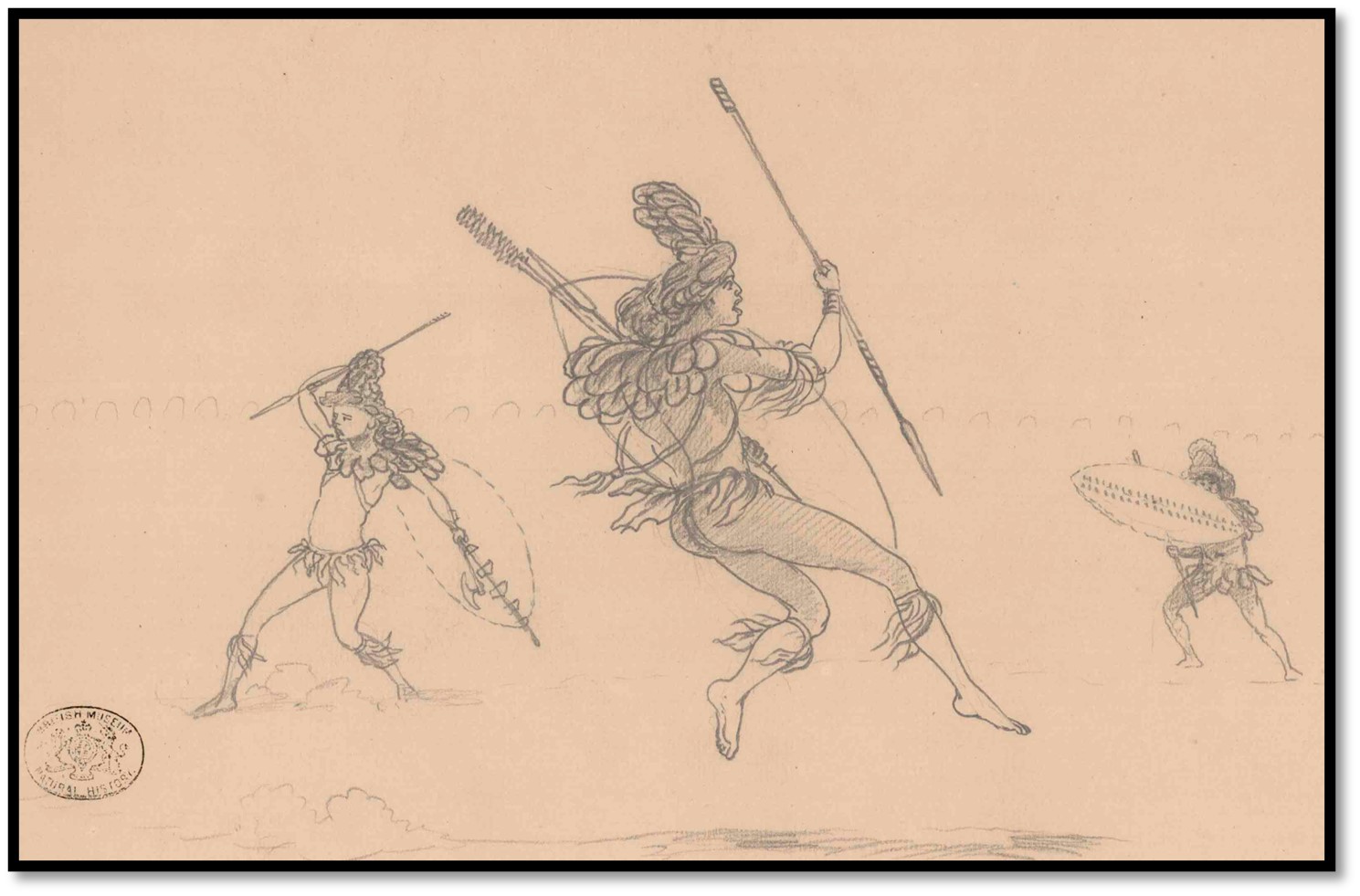
NHM (London) Baines Collection No 64: young warriors, majokka [Majaka] dance before Lobengula
4-Aug The wagons arrive after breakfast. Baines shows Lee the letter from Shepstone and he will tell the king of its existence but leave the king to decide when he receives it. Kisch, the former storekeeper of the London and Limpopo Mining Company is now Lobengula’s secretary and has been writing all of his letters and may be asked to interpret Shepstone’s letter.
5-Aug Jewell and Baines look at the stores left behind the previous year and pick out those useful for barter. Some have been eaten by rats and other items, such as caps for the percussion muskets, stolen by native servants whilst Lee was away. In the evening Cornelius van Rooyen drove in a large bull eland that stood in the stream until fatally shot and was dragged out by a span of 8 oxen. Another had been shot 800 yards from the house by David Jacobs and Baines took his sketch book to the scene. A good description and measurements follow in the diary.
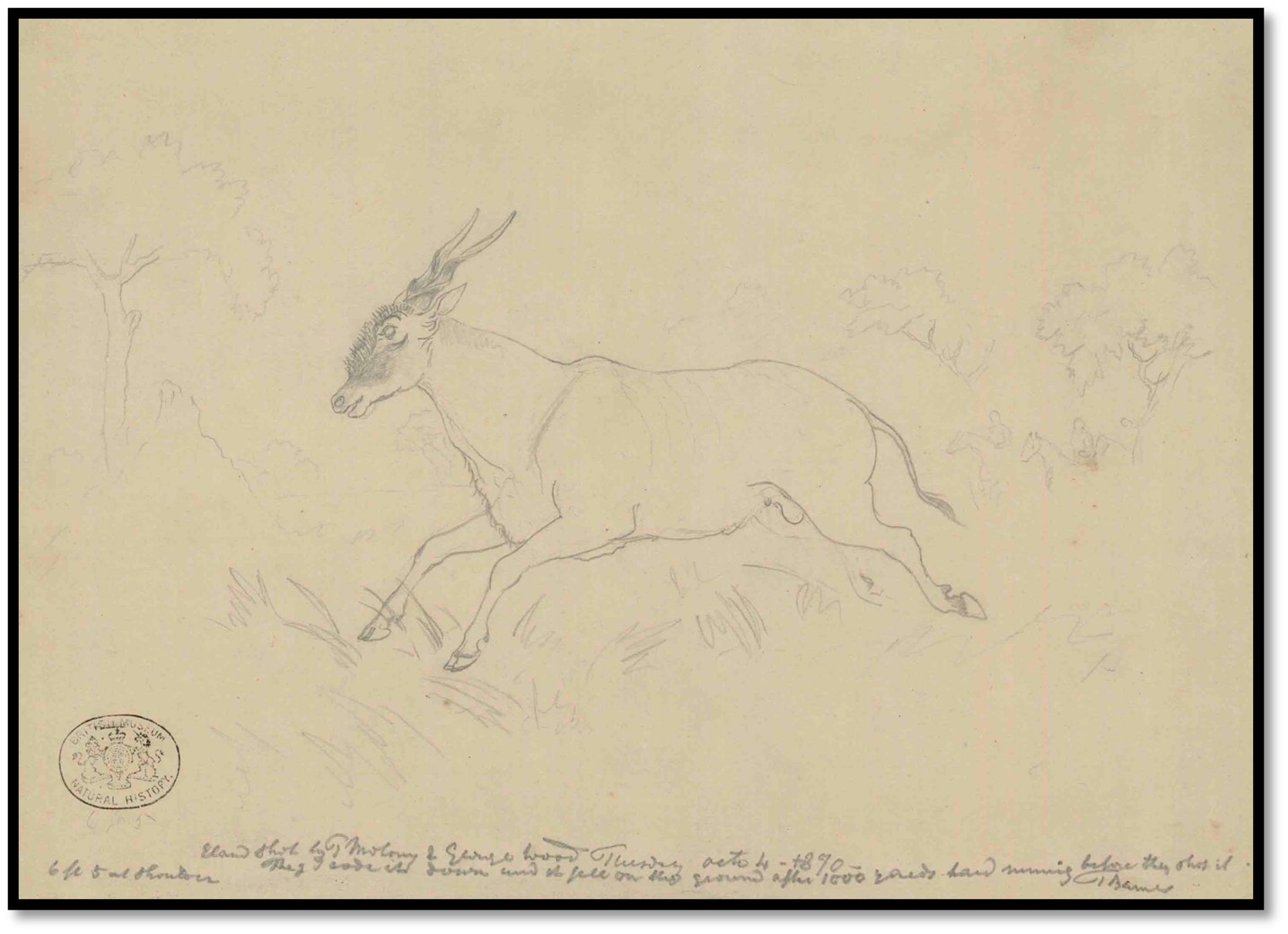
NHM (London) Baines Collection No 136: Eland bull 6ft 5 inches at the shoulder shot by Thomas Maloney and George Wood on 4 October 1870
6-Aug All hands are involved in skinning and cutting up the eland. John Lee and Baines discuss the stability of the South African Gold Fields Exploration Company. Baines says that he can tell him no more than what is in Edwin Oliver’s [the London company secretary] latest letter…that prospects are good and cost estimates for crushing machinery are being obtained and “there will be no difficulty about Mr Lee’s appointment if all goes well.”
Baines, despite the signs that the company lacks funds, believes “the company will succeed in organising itself so as to go on working…” and at the same time believes: “I felt it to be my duty to act to the best of my ability for the Company assuming that it would be able to carry on its own share of the work successfully until I should hear to the contrary.”
Lee now believes it would be better that he interprets Shepstone’s letter to Lobengula [rather than Kisch] unless the king wishes otherwise…”I had no doubt from the first that he was the proper person to do so.” They discuss the possibility of getting a written grant from the king for the company’s gold claim at Hartley Hill but are of the opinion that no written grants will be issued after the problems caused in the Tati district by Levert and the London and Limpopo Mining Company. Baines believes that if he trusts Lobengula’s word regarding mineral rights he will not retract his permission to explore and work anywhere within the limits granted. “Besides which, now that the company is supposed to be in difficulties and ourselves reduced to the barest necessaries of life obtained upon our own personal credit from friends whom we have found in South Africa, I hardly feel in a position to speak with that confidence which is necessary to the making of an advantageous treaty.”
7-Aug Discussions with Christiaan Harmse ‘Old Chris’ about the rivers encountered in travelling on foot from the Limpopo to the Sabi river.
8-Aug Sent Stephen Gee on with the wagons and travelled with Lee over the Semokhia (Simukwe / Semokwe) river to Manyame’s village and shortly after he appeared. Manyame said he had been chastised by the king for allowing old and well-known travellers to go through without sending messengers to the king. Lee told him Baines had letters for the king that Manyame knew about, but nevertheless he needed to send messengers on ahead. Baines gave Manyame a jacket and some powder and lead for the messengers.
Then the Shashani rivulet was crossed on a new road below Boulder Pool or Baldwin’s Hole, and outspanned under Eagle rock called Impoonzie (Duikerbok hill)
9-Aug Left Eagle rock and the Shashani river and then passed Watchdog rock.
10-Aug Near Umvolulu’s kraal went looking for game and when the wagons came up Jewell said Gee was ill and had vomited a cupful of blood. He was given a dose of opium in water and told to lie in the wagon and soon recovered. As they passed Zeeslashiu Zingwe (Bush of the Tiger) then saw amaNdebele women digging the ground for cultivation (gardens) The proteas that are common on the higher ground give way to mimosa as they descend towards the Kumalo river (does Baines mean the Khami river?) Local people report that the king left Gibbeklaik yesterday morning and is now somewhere near Revd Thomson’s Hope Fountain mission.
11-Aug trekked the road to the king’s crossing the watershed and passed Inthlathlangela to reach Gibbeklaik where they found Harry Grant,[iii] Charley Meyers [Karl Meyer] and William Francis.[iv] Baines thinks the letter from Shepstone to Lobengula that he is carrying will give him more status with the king as showing he is trusted by the Natal government.
12-Aug They follow the king down the valley towards his kraal on the Umzingwane [where they went the previous year] and they notice abundant quartz. They meet Kisch on horseback who tells them the king is not at the kraal they know, but 2-3 miles to the east. They prepare a drift across the Umzingwane with spades and picks and turn east on the southern bank where they are joined by Jewell and Revd Thomson and outspan near Kisch’s wagon at the neck in a range of granite hills.
Baines has a marble slab in memory of those who died in McNeil’s party and as he was not going to Inyati this year asked Revd Thomson to place it on their graves. Thompson said he and Revd Sykes and friends would see to it. A draft drawn by Baines as a contribution to the Inyati mission had been returned by Edwin Oliver, the London company secretary because there was no letter of advice with it.
They paid a visit to Lobengula who was reviewing one of Umtigan’s regiments. The king asked Lee if the news from Natal was good. Baines are sent for, Jewell stays behind to polish the gun to be presented to the king. About 120 amaNdebele women are dancing for the king, each armed with a large wooden ladle and small shield and stamping their feet in time to the chorus which they sang. Soon Lee and Baines were called for an audience and crawled through the low arched hole that served as a doorway into the presence of the king and his favourite sister Jung yin or Nini.
Lee told the king that the South African Gold Fields Exploration Company had received news of Baines’ success and the king’s grant and thanked the king for his kindness towards them; that they would send money and machinery to work the gold claim at Hartley Hill that would be brought up from Natal next year.
The king appeared satisfied. Next Baines said he had seen the Natal governor and told him of the king’s and Ncumbata’s permission to explore and work the goldfields. The governor had given him a letter acknowledging the friendship and kindness of Ncumbata and the king and as the letter contained a message of great importance to the king he would read it to him. Lee asked Baines to read it slowly and with short sentences so he could interpret it accurately.
The core of the message was that a person, representing himself as Kuruman was living in Natal and had been recognised by Mangwane and others as the true heir to the amaNdebele and intended to come up and claim the chieftainship. The Natal government sent this information so that the amaNdebele might decide peacefully and without bloodshed on this important information, but the Natal government would take no part in this matter and leave the amaNdebele to settle this question alone.
The king listened patiently, asked questions about Kuruman’s supporters and when he was coming up, etc. He said he would answer the governor, but in the meantime asked Baines and Lee not to make the contents of the letter public.
13-Aug About midday the king’s 3 wagons came by accompanied by soldiers and people driving goats and valley and Kisch, Lee and Baines inspanned and followed going west up the valley of the Umzingwane river as far as where the king made his kraal the previous year. After outspanning they visited the king where 6-8 oxen were butchered with their hides stripped off to make shields.
14-Aug In the morning the king visited Baines and they sat in the sun with Kisch and Lee. Afterwards he walked with Lee and asked him about Kuruman. Lee said the person in Natal claimed the name of Kuruman but that it was a question for the amaNdebele people and the Natal government would not take part and had asked all its citizens not to take sides if a dispute should arise. He told the king that Baines had known Lobengula before and after his succession, had received his mining privileges from the king and recognised him as the sovereign of the nation.
Lee said that though Baines trusted the king and had not yet asked for a written grant concerning the company’s mining claim it was customary and his company was asking him for it. The king replied that he knew this was the custom of white men. Baines had already prepared a draft that is quoted in full on Page 674.
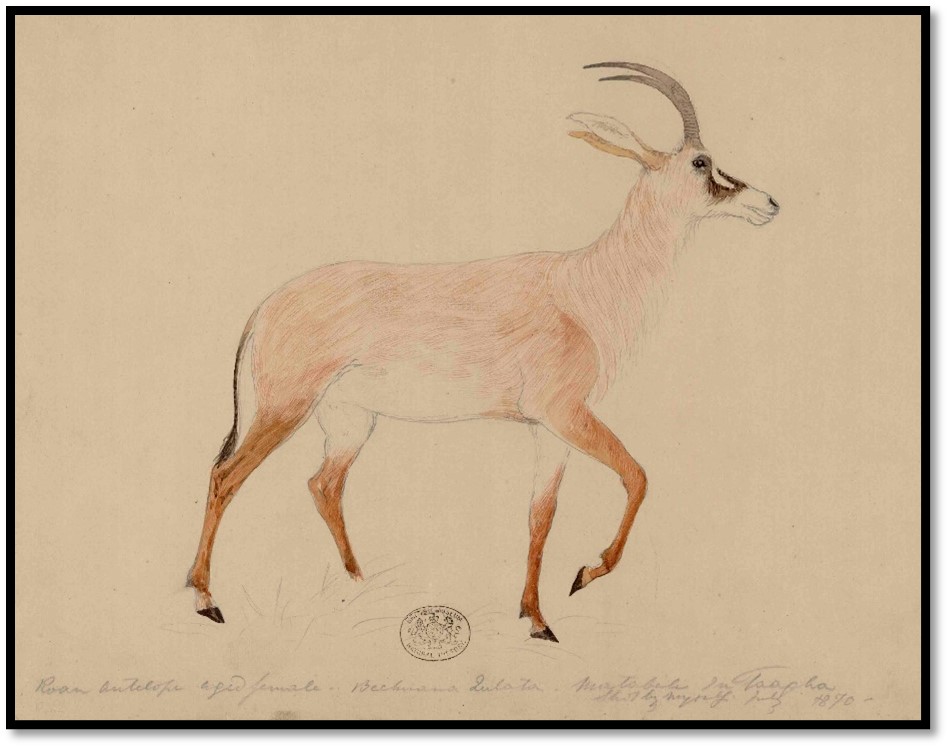
NHM (London) Baines Collection No 140: aged female Roan Antelope (Hippotragus equinus) shot by Baines in July 1870
15-Aug Lee sends his servants down the Umzingwane for bamboo canes to use as whipsticks. On foot it is one day’s journey to Umtigan’s village and two more to the Whipstick kopjes.
The king said a child of one of his sisters was sick and asked if Baines would go by horseback to see it. Baines said he would rather the child was brought to him and he could see it daily.
Then Baines said that his company in England had to deal with many people who required some evidence of the agreement granted by the king as they did not know him and Baines could not go home and speak to them all. Lee added that men might die and words passed by mouth might be altered, but that writing would remain the same forever. Then the king said: “Yes, I will give him a writing.” Lee said thanks and the matter is considered closed as the king’s word can always be relied upon.
In the evening Lee and Baines discuss a new route down to the Limpopo river and the peril of tsetse-fly to their oxen. They think there will be no difficulty in finding a drift across the Limpopo unless it is in flood.
16-Aug Baines is making a box to contain maps. A princess is given vinegar and laudanum for an eye infection. Nini has a large swelling on her forehead from a falling pole that gets bandaged with vinegar and brown paper. More general conversation with the king. Letters from Revd Sykes whose children have collected flowers and butterflies and put them in an envelope. Also two from Revd T.M. Thomas from Cape Town asking for photos from Baines’ sketches that he can show the public. Lee came in to say that next day the king would come for Baines to write his replies to Shepstone and the Portuguese consul and would also sign the grant of mining privileges requested by the South African Gold Fields Exploration Company.
18-Aug The king arrived and began to dictate his letter to the Natal governor. He thanked the governor for his friendly message and then related the events around the death of Kuruman. Of his efforts to find his brother and his refusal to accept the chieftainship until Kuruman was proved to be dead.
Afterwards they shared a meal of roast beef and beer with the king followed by a shooting match. Baines tried to persuade Ncumbata’s son Umthlabba to go down to Natal with him to question the person claiming to be Kuruman, but he and the king both fear treachery.
19-Aug The king continued dictating his letter to the governor but at times it tended towards rambling and incoherence. Baines edited the letter by producing a first rough draft that was then corrected and finally read it to Lee who translated it for the king. Once he was satisfied, the king made his mark. Afterwards Baines carved him a wood block with his name in raised letters like printer’s type and then cut him another with sunken letters for a seal.
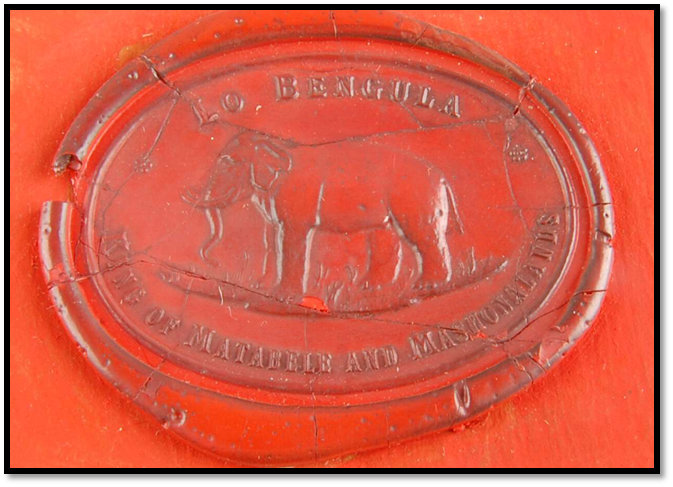
British Museum: an impression of Lobengula’s seal with inscription and Elephant carved by Thomas Baines in wood
Lobengula’s long letter on Pages 683 – 687 of the diaries is not reproduced here except for the words of the witnesses: “Now when these witnesses Gwabaiiyo and Gualema, were called before the council of the nation about August 1869. Gwabaiiyo said the King's [Mzilikazi’s] orders to him were: ‘you must not stab him with an assegai; you must not strangle him with the riem; you must not bruise him with a keerie [knobkerrie] but you must take his head in your own hand and kill him by twisting his neck so as to dislocate it’ and he said he killed him according to these orders.
Gualema at the same time disputed the manner of Kuruman’s death and said Gwabaiiyo did not adhere to the orders of Umzilikazi, but took bark off a tree, twisted it into a rope and strangled him [Kuruman] by twisting this about his neck. He also broke his keerie in striking Kuruman, but both agreed that he was put to death.”
25-Aug The king came over early and had breakfast at Baines’ tent. It appears that Kisch’s nose was put somewhat out of joint as he is Lobengula’s secretary, but as Baines brought up the letters the king also wants him to write the replies.
The king wanted to add to the letter to the Natal governor on the character of Mangwane or Umangwane who had fled to Natal and who stated the Kuruman claimant was the lawful heir of Mzilikazi. The substance of what Lobengula wished to add was: “during the old age of my father Umselegasi, [Mzilikazi] Mangwane, his eldest son, took one of his father's wives, named Mathlanganyana, whose father's name was Goongwe. He slept with her and she became with child by him. Such a crime in Matabeleland is punishable with death and Mangwane knowing this, fled from his country with her about the time of the death of Umselegasi. He did not leave for the purpose of seeking the king, but for fear of punishment as soon as the new king should be possessed of power.”
A fight had occurred between Gee the wagon driver and January, a Fingoe [amaMfengu] from Hopetown that the king was drawn into that ended with January paying a fine to Baines of an elephant tusk. The incident is described on Pages 688 – 692 of the diaries. In the afternoon about 800 warriors arrived to display their new shields and went down to the Umzingwane river to have medicine sprinkled on them to render them invulnerable to assegai or musket ball and afterwards danced before the king.
26-Aug In the evening those who went for whipsticks arrive back from travelling down the Umzingwane, Baines estimates 70 – 80 miles. In the evening a ‘little conversation’ with Jewell who is a good-hearted generous fellow and does anything about the wagons but despises an illiterate transport driver and thinks they are an object of ridicule. Baines says in the company of his white friends it is impossible to get any steady work done out of Jewell.
27-Aug Kisch going to Bokwelo’s to trade for corn. George Phillips going to Gibbeklaik or Gubulawayo[v] and taking a blanket from Baines for Ncumbata.
28-Aug Lobengula came early and did a little letter writing with Baines but a regiment arrived for review and the king had to leave for the day.
29-Aug Lobengula came again and after the letters to Pretorius, the president of the Transvaal Republic and Van Zeller, the Portuguese consul were complete he said he was ready to sign them all, including the grant of mining rights to the South African Gold Fields Exploration Company. [See the Appendix] This was read back to him in short sentences with Lee interpreting and George Phillips and Betts, a trader.
30-Aug The king came again and further letters were written to chief Sechele and Henry Hartley.
31-Aug All busy packing up. “All our friends who had a right to farewell presents came for them and all who had none came upon the chance of getting something.” Jewell sold his gun to the king for 200 lbs of ivory. Baines said he was sorry because Jewell will be unable to shoot anything going down “but it cannot be helped as we must pay debts incurred for provisions and other expenses.”
Jewell and Baines remained after the wagons set off. The king asked if they had received some beef and was told only a sheep and sent his boys with a leg and some ribs of beef after the wagon. Then bade them “Go pleasantly and come back quickly.” They overtook Lee at the Umzingwane drift with some trouble getting through it.
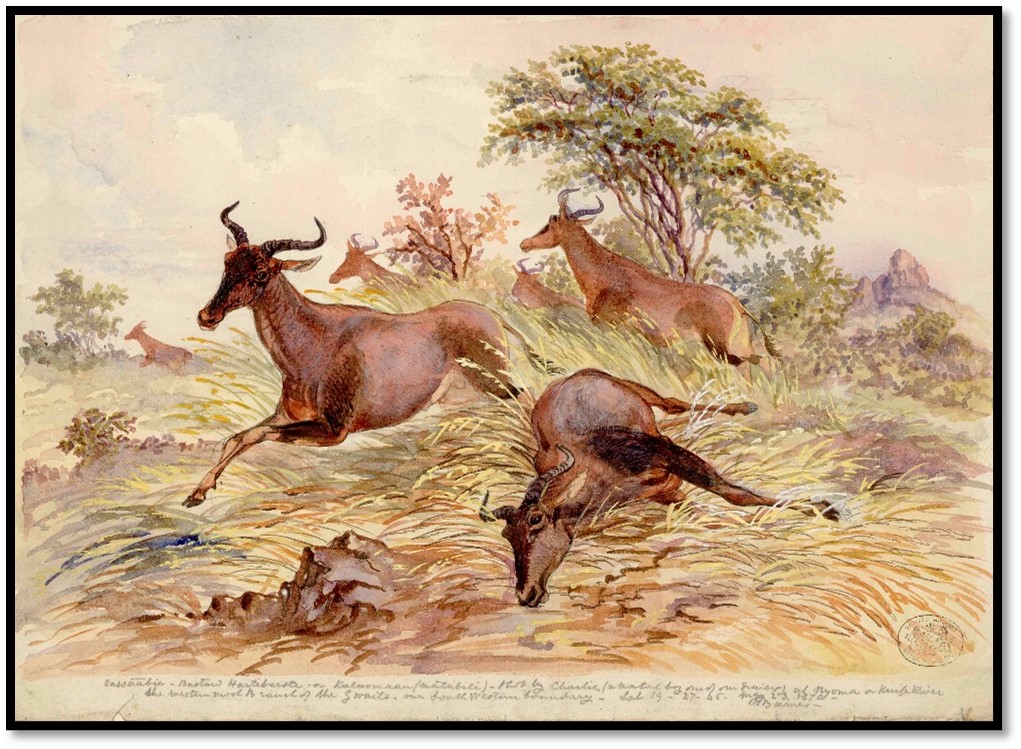
NHM (London) Baines Collection No 147: Sassasbee (Tsessebe) shot by Charley, a wagon driver at Ngamo rivulet, a tributary of the Gwailo (Gweru) river on 23 May 1870
September 1871
1-Sep Trekked early and it being Mrs Lee’s birthday drank her health before moving ahead on horseback to Old Bulawayo [or Gibbeklaik] where they found Phillips in the royal enclosure with Umziligazi’s widow. A fine wagon is under thatch but left to rot because Mzilikazi used it with another going to pieces. One or two were destroyed at his burial. Phillips weighed off and handed over the correct amount of ivory to Lee [for a horse] and Jewell [for his gun] Baines gave Mzilikazi’s widow a blue blanket and went to pay respects to Ncumbata who was weak, but his intellect as clear as ever. They drank beer with him and the widow and in the afternoon rode over to Hope Fountain 3 miles away and were welcomed by Revd and Mrs Thomson.
2-Sep They unloaded the gravestone intended for those members of McNeil’s party who died at Inyati mission. Revd Thomson will have it placed on their graves. Revd Thomson climbed the hill above the house with Baines with views SSW to Old Bulawayo, to Ntaba Induna in the NNE, to the hills where Umtigan lives ESE and SE down to the Umzingwane river.[vi]
4-Sep The wagons are repacked – they now have little more than personal equipment. Jewell and Gee go on with the wagon and Revd Thomson sent his wagon also to buy corn at Makhobe’s or Matopola at the ‘top of the Hill.’ Baines stays behind because Ncumbata is brewing beer and it would be an insult not to drink it and partly to give Revd Thomson an opportunity to write letters.
Thomson gives Baines a letter for Oliver, the company secretary, giving his opinion of the prospects for the company’s claim and the value of the king’s verbal and written promises. Baines gives the Thomson’s as much of his medicines that he can spare, he knows any ill travellers will go to the nearest mission.
5-Sep Revd Thomson rode with Baines from Hope Fountain to Old Bulawayo where they saw Mzilikazi’s widow and Ncumbata whose beer was still cooking in large pots upon the fire and therefore not yet ready to drink – “for which I was not sorry.” Ncumbata was given a black woollen blanket and Baines said farewell and said he hoped to see him again in 5 or 6 months. He stopped at Umkaitjo’s village at the Kumalo river, but he was absent and Baines spoke with Bulana, their old guide and Umkaitjo’s wives.
At Umvolulu’s he met Robert Acutt, the London and Limpopo Mining Company’s storekeeper who was going to see the king with papers brought by Patrick MacGillivray (McGillewie) from Potchefstroom but had no letters for Baines.
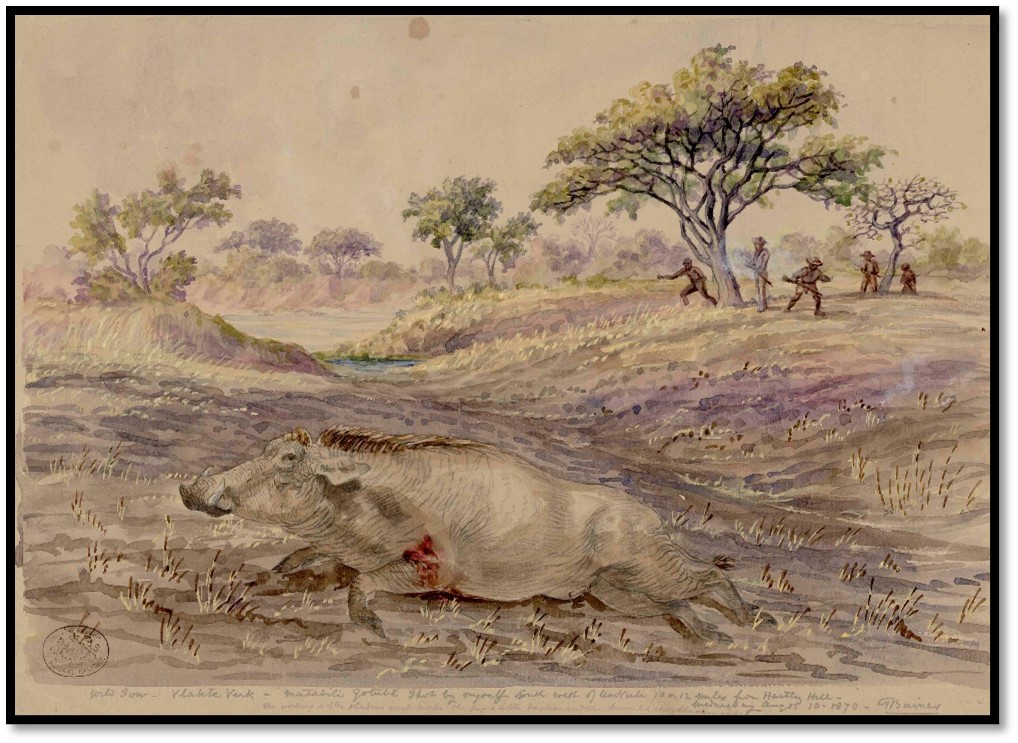
NHM (London) Baines Collection No 126: Female warthog shot by Baines 10-12 miles downstream of Hartley Hill on the Umvuli (Umfuli / Mupfure)
6-Sep A long letter to Shepstone is copied on Pages 706 – 708 detailing all of Baines’ encounters with the king. Halted that night at Makhobe’s or ‘the top of the hill.’
7-Sep Jewell buying corn for Revd Thomson. Matchaan, the wagon driver, said he had left his blankets at ‘the top of the hill’ and has gone back with some personal plan in mind.
8-Sep Paid off two of the Makalakas, keeping two.
9-Sep At Lee’s house who advised a letter to the king as Matchaan’s absence as wagon driver will delay the royal letters…this Baines did.
11-Sep Jewell and Baines leave Mangwe for Tati. At the Inkwesi they meet Revd Sykes and family coming from chief Sechele’s country where they congratulated Mrs Sykes on her escape when a lion had got to the front of their wagon and attempted to get inside but could not get its nose under the canvas curtain and then escaped.
Baines receives a letter from “Sandy” Brown at Tati with the information that a new South African Goldfields Company Limited has been registered with a share capital of 30,000 £1 shares to work the claims granted to its predecessor. 10,000 shares have been issued to the original company for the mining privileges it obtained.
12-Sep Reached Tati and welcomed by Nelson who gave Baines a copy of the new company’s prospectus…he hopes it will be ready to begin working soon. Glass and Arkle have brought Charles Hart’s steam engine and stamp-mill for crushing gold to Tati to be used by independent miners such as Griete at the Blue Jacket mine as well as the London and Limpopo Mining Company. [L&L MCo] Baines had dinner with Charles and Mrs Hart and enjoyed the luxury of plates and cutlery. He writes that Charles Hart is building a house at Tati and an engine shed about ¾ mile down the river.
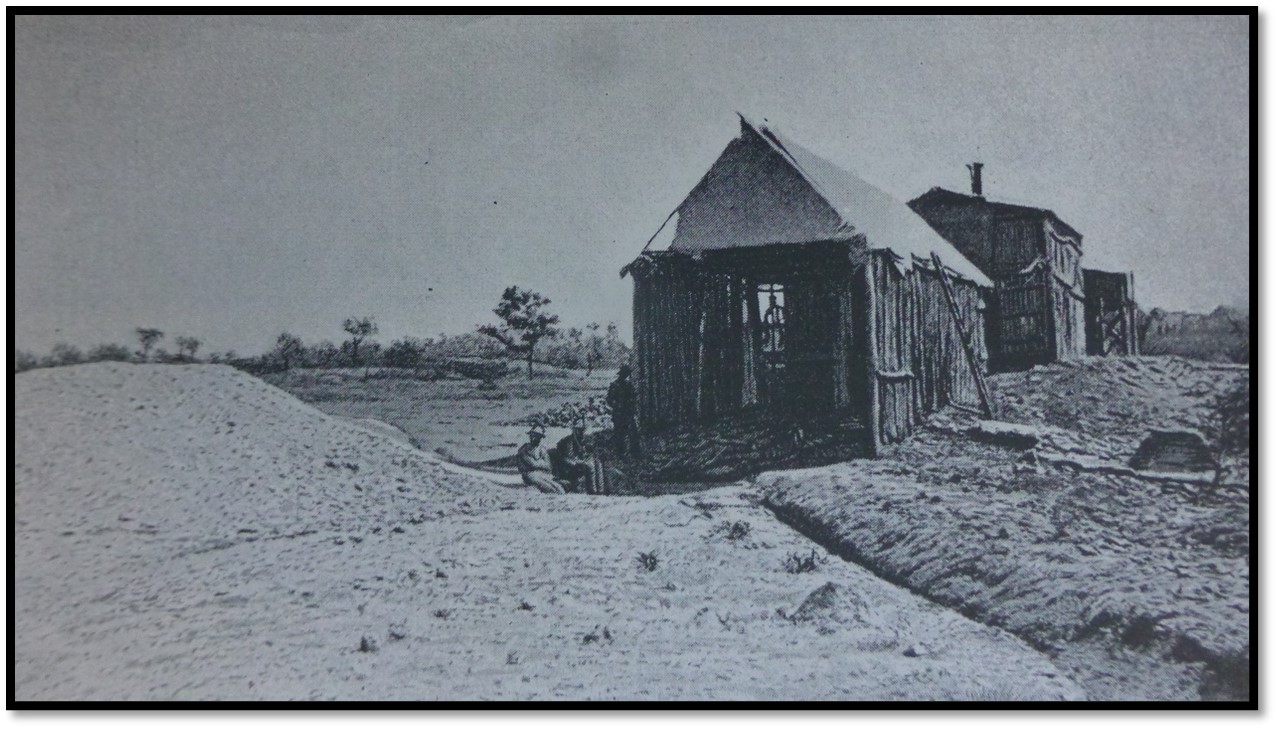
Gold-mining plant at Tati: originally published in Austral Africa
Although Nelson is pegging out claims for the L&L MCo the other prospectors at Tati question the right for the company to claim all the land between the Shashe and Ramaquaban rivers and grant claims on any terms whatever to others. Baines believes Arthur Levert was not given the power by Lobengula to admit or exclude others, some of whom had pegged their claims before the L&L MCo had even arrived.
Hart says he has paid a fee to the L&L MCo but wanted to know if he should pay a second fee to the king. Baines advised him to go and pay his respects to the king and said that the king himself would settle this question, also that they should send a deputation to the king with Lee as interpreter to settle the authority given to the L&L MCo. Baines expects nobody will oppose the L&L MCo and the question will remain a source of annoyance to the other Tati miners.
13-Sep Baines is writing letters informing those concerned that the king has signed a written agreement for the northern goldfields. Jewell wants to buy a horse from Brown but Baines says he can do no more for the company having pledged all his property and stretched his credit to the limit.
14-Sep “Writing all day til my eyes and wrist ache. It requires a strong hand to do four copies at once.”
15-Sep More letter writing. A fruitless discussion with Patrick MacGillivray (McGillewie)
16-Sep Thomas McMaster arrives from the Mababe flats between the Botletle river and the Zambesi with 1,200 lbs of ivory and ostrich feathers. Baines sealed letters to the Natal governor, president Pretorius, Van Zeller, the Portuguese consul and chief Sechele.
17-Sep He went down to the Tati river for a bath but found the engine pits full of Griqua’s washing babies and their clothes.
18-Sep Those at people currently at Tati are:
For the London and Limpopo Mining Company: C.J. Nelson (mineralogist) E. Arkle (engineer) August Griete (miner – about to leave) H. Gren (asst. miner) Robert Noble Acutt (manager) Franklin (storekeeper)
Alliance Reef: Alexander Brown, Dr Coverley (away in England)
Australian party: George Hall, Hugh Dobie, Henry Smith, Charles Brown, John Hagen-Meyer
Todd’s Creek: Arthur Crawford, William Runyard
Hart’s party (engine and crusher) Charles Hart, Mrs Hart, Seymour Stevenson, Robert North (engineer)
Griqua party with no regular occupation
After an early breakfast they saddled up and reached the Inkwesi river.
19-Sep Arrived at Lee’s and was told by Henry Byles that Matchaan said he had not run away but wanted to work for Nelson. Byles says tsetse-fly is present at the Sebakwe drift and therefore going in next time he should turn right at the Bembezana and go south as far as the foothills and come back to the Hunter’s Road again between the Umgesana (Ngezi) and Umzwezwie (Umsweswe) rivers.
He also says that 1½ days walk east of the company house at Hartley Hill there is a large rock at which the Mashona perform religious ceremonies and beer is offered to the deities.
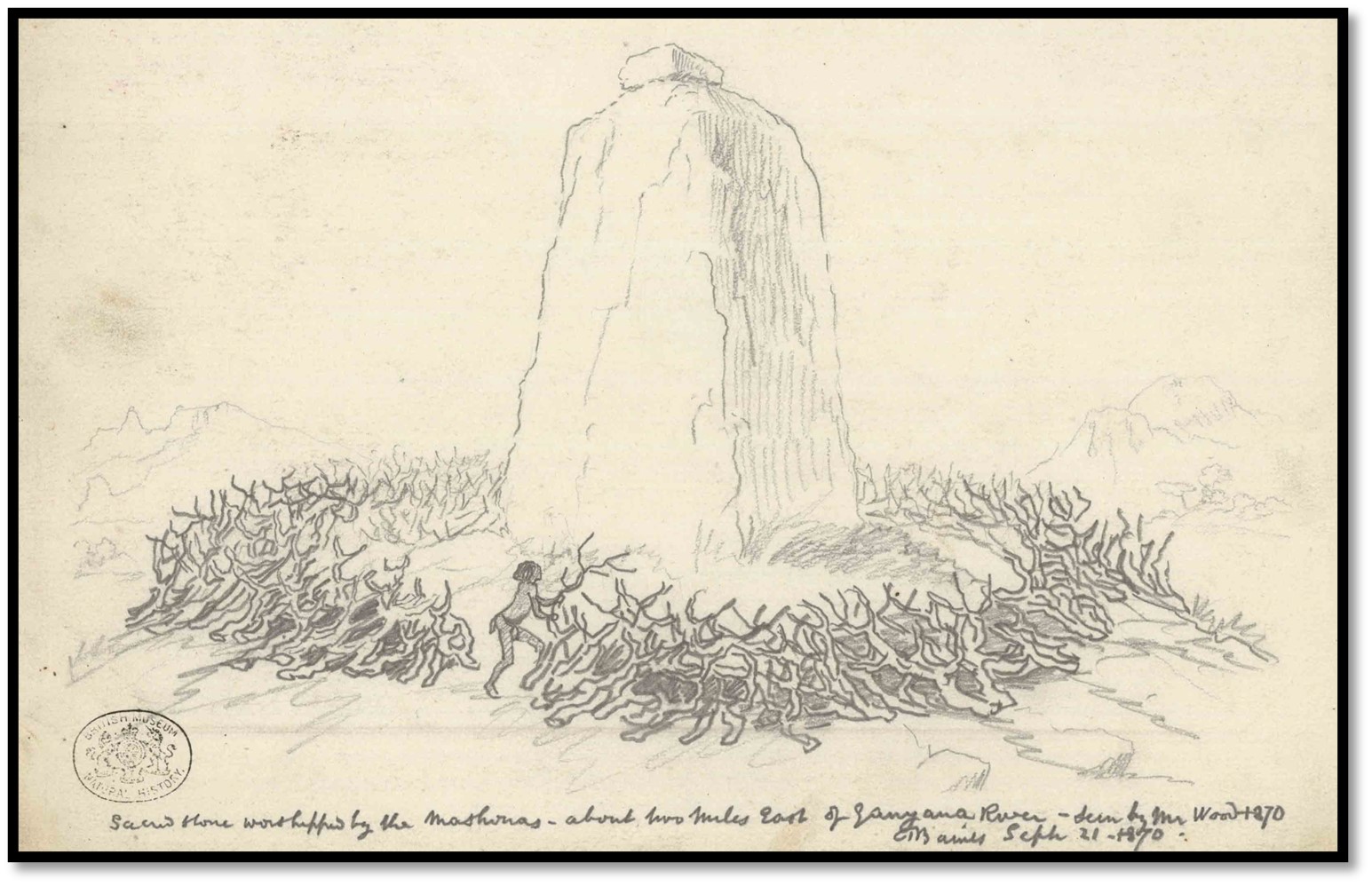
NHM (London) Baines Collection No 51: Sacred stone worshipped by the Mashona about 2 miles east of the Ganyana (Hunyani / Manyame) river
20-Sep Baines is fitting the trocheameter to the wagon wheel. One of Lee’s sons made him a pair of veldschoens with buffalo soles and hyena uppers. Arkle has put a new glass into his compass.
21-Sep Byles showed a bunch of ostrich feathers worth £45.
22-Sep Karel Lee hired as wagon driver to Natal and back on the understanding that if the company has failed, his employment ceases also.
23-Sep Jewell returns with 8 muids of corn (about 1,440 lbs) but no goats. They send the trek oxen away up river as some of Lee’s cattle have lung sickness.
24-Sep Shifting and dividing loads so the weight is equal in the wagons. Baines receives a letter from the trader Blanch at Bamangwato on the existence of unicorns who points to painted examples in San rockart.
26-Sep After an early breakfast with Lee they departed although Jewell’s wagon went through the Mangwe drift but Baines wagon was stuck in the pull-out. Dutch friends came to help, but Stephen Gee, the driver, insulted them and threatened to leave. Baines said he might go, but he should not insult men who came to help. He went back to work but Baines felt the oxen got the abuse and a savage cut or two.
They travel south “winding among granite hills of most picturesque and fantastic form” travelling 8 miles in the morning.
27-Sep Another morning trek of 3 miles in a winding path amongst the granite kopjes through dense bush. As usual Baines walks ahead and when the wagons arrive finds the front bow of the tent frame and sail of the wagon have been damaged. The tent is immediately repaired although it takes 2 hours. In the afternoon trek they travel over 6 miles and see their first baobab tree (Adansonia digitata) The hunters shoot two giraffe, but at one Herbst went and took hold of the horns and at the same time was lifted off the ground and thrown some distance with violence. He got up and wounded the animal and he and Karel Lee had to catch their horses and give chase again before killing it.
28-Sep Karel Lee shot 3 wildebeest but so far away they could only bring back a small proportion of the meat. Trouble in-spanning a wild ox in good condition swapped with Betts for our trained ox in rather poor condition.
29-Sep Came to a drift on the lower Mangwe river, but Karel Lee thought there might be a better one lower down, there is no real road and they follow the tracks of past hunters wagons that are nearly obliterated, trekked over 5 miles. In the afternoon Lee and Baines went out looking for buffalo but without any success.
Back at camp after much effort they caught a Bush baby (Galago or nagapies) and made a collar of soft riempjie and tied it to Baines wagon where during most of the day it hid itself in side-pocket. He fed it by hand with water and sugar and if annoyed it would give Baines a sharp nip with its little teeth.
30-Sep Crossed to the west side of the Mangwe river with two spans needed to pull Baines’ wagon through the heavy sand. Travelled down the west bank of the Mangwe to its confluence with the Semokhia (Simukwe / Semokwe) river and found Jennings snr and one of his sons and Potgieter camped on the bank. Potgieter supplied useful information on the areas with tsetse-fly and routes to the Limpopo river.
October 1871
1-Oct Baines went for a wash in the river, but there were few pools and the water percolates under the sandy bed that is 100-200 yards wide. They have travelled 46 miles from Lee’s farm. Baines was showing the Bush baby to Jennings snr when it gave birth to two young offspring.
2-Oct They bought two oxen from the younger Jennings for £9 to be paid in Natal and their friend Henry Byles paid Jennings snr £10 for a pair of after-oxen and lent them to Baines. Trekked 5 miles along the Semokwe river bank that proved level and open. In the afternoon crossed thickly wooded areas of red sand with outcroppings of granite and quartz and Baines collected samples of a beautiful pale blue flower.
3-Oct An early trek of 6 miles along the riverbank and in the afternoon through thick bush with Byles and Baines going ahead with servants and axes to clear a path.
Latitude 21° 29´ 41" S
4-Oct Crossed to the east bank of the Semokwe and saw buffalo that Christian Herbst, Smidt, Piet Lee and Baines stalked. All their bullets hit and the wounded animal charged them although some rocks tripped it up and gave Baines the chance of another shot. The animal was assegai’d but rose until a final shot from Baines put it down.
In the afternoon they passed through the Semokwe poort and halted 1¾ miles short of its confluence with the Shashe.
Latitude 21° 36´ 13" S
5-Oct Jewell and Baines ride down to the Shashe with its broad sandy bed 100-200 yards wide and like the Semokwe the water percolates below the sand. A mile below the confluence they found a drift where the wagons could cross and saw elephant spoor in the sand. Now the hunters in the party affect indifference and are trying to throw the others off the scent.
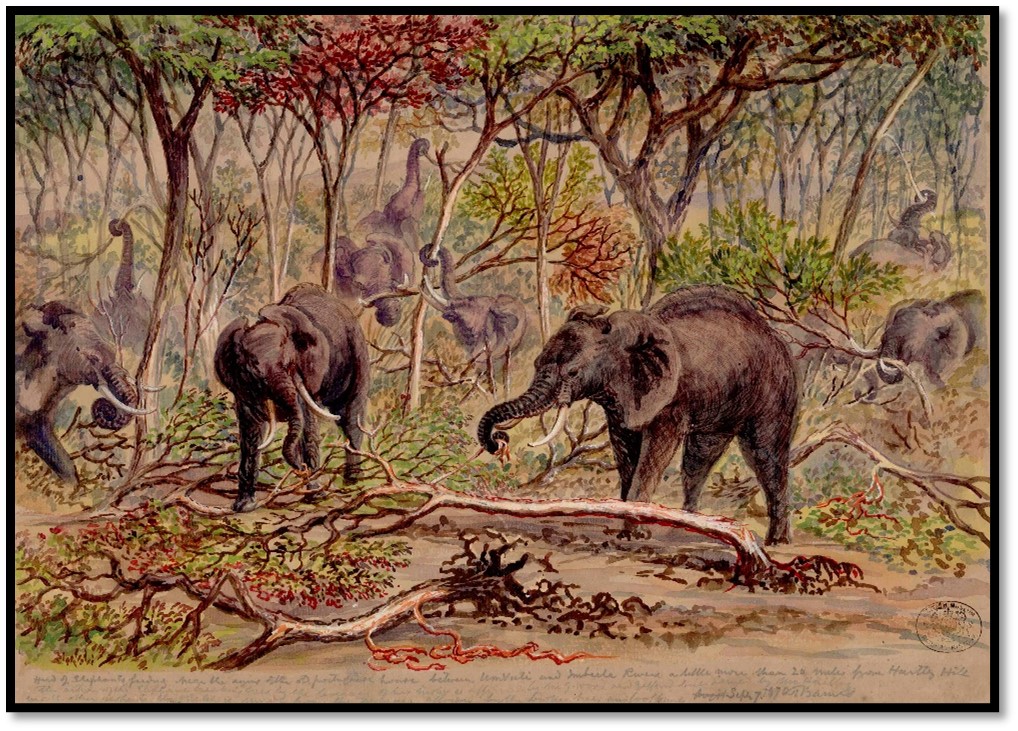
NHM (London) Baines Collection No 102: Elephants feeding between the Umvuli (Mupfure) and Imbeela rivers Mashonaland on 7 Sept 1870
6-Oct Karel Lee shot a buffalo but at such a distance only a small portion of meat was brought back.
7-Oct When they came to the Shashe the hunters wagons went down the bank, but Baines did not want his wagon tent smashed and took them on to the drift they found the previous day. Their wagons crossed and outspanned with the hunters. Baines writes that his Dutch friends are starting on Monday for the Macloutsie river and he will accompany them but he must be prepared to travel alone if they suddenly encounter elephants as the elephant-hunters movements are always unpredictable. They fish for barbel in the Shashe.
8-Oct Baking bread for the journey. Gee will interpret with the small Khoisan group they encounter who do not speak the Bantu languages.
9-Oct Baines says farewell to the others and thinks Lee will take his sons to task for their faint heartedness. Gee drives the wagon to the south-west and within an hour reached a large baobab of 40 ft in circumference
with remains of fires inside as if it is used occasionally by the Khoisan for shelter. Suddenly they came upon a black rhinoceros, Gee fired and hit but Baines’ gun-bearer had so many objects attached to his gun that by the time it was clear of them the rhino was almost out of sight. Soon after they struck wagon spoor but the route meandered and they took a straight course and came upon another baobab with a girth of 50 ft.
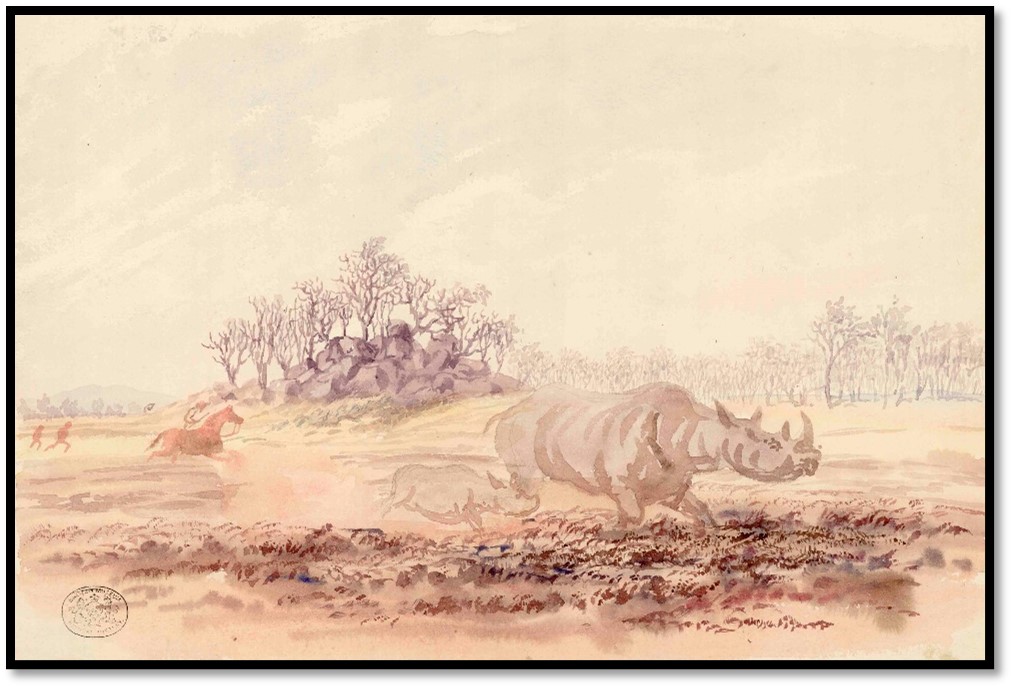
NHM (London) Baines Collection No 116: rhino and calf being chased by hunters – no date or place given
Fired at some giraffe without effect. They could have been chased by horse but they are unsure if they are in a tsetse-fly belt and dare not risk it. In a range of granite kopjes they heard growling and spotted a half-dozen lion cubs that Baines thought at first were warthogs. One lioness of the three adults remained in the open uttering growling threats until a shot made her take cover.
On the top of a kopje Gee found a pool of water where they drank and refilled their cans. In the distance they could see a double line of trees marking the course of a river. They trekked in a more or less straight path for the river that was reached in 2½ hours and dug in the sandy bed but only found wet sand. They made a fire and spread their blankets under a clump of trees.
10-Oct Started early to find water seeing fan palms singly and in groups 15 ft high. Digging in the river yielded no results but a little spruit did reveal water when a hole was dug. After a breakfast of coffee and meal cakes they followed the river going mostly south and keeping a sharp watch for tsetse-fly. At a spot where a band of rocks stretched across the river was sufficient water for the oxen to drink. A Pallah (duiker) was wounded but got away. Gee and Baines both hit and wounded a large bull buffalo that charged them and then got away. Two splendid yellow-maned lions were seen only 15 yard away, but the servants shouts frightened them quickly away. Baines finally shot a monkey off the top of a high tree and its hindquarters were eaten for supper.
11-Oct At sunrise left the river and their wagon and after 3½ hours entered a range of hills with an easy passage for the wagon and halted under a baobab for coffee. Gee and their servants tried to smoke out bees and were only stung for their efforts. They found baobab fruit but the ‘cream of tartar’ was white and dry. They were not able to reach the wagons and after a coffee supper slept under thorn trees.
12-Oct After climbing a small kopje to orientate they reached the wagons where they learnt their Dutch friend had gone up the Shashe to hunt. Karel Lee caught a young horned owl for Baines. Henry Byles advised a more westerly course to clear the tsetse-fly belt.
13-Oct Left about 10am to let the oxen drink and made two treks, both over 7 miles. Found fresh tracks of a wagon that had come from the Limpopo river and then returned.
14-Oct Early they inspanned and trekked south-west to the range of hills they had previously visited. Once through them they trekked for a further 2½ hours and reached the Macloutsie river and drew the wagons up under some Kameeldoorn trees, commonly called Acacia erioloba. Karel Lee, Byles and Gee went out to find some meat, but found nothing.
15-Oct Went out with Gee and shot a female snake full of eggs. Spotted buffalo spoor but they were not seen.
16-Oct Rode out with Byles and Jewell, Byles shot a Pallah doe (duiker) and a steinbok (steenbok – Raphicerus campestris) The carcases brought vultures and they brought Khoisan who told Byles that the wagon spoor they had seen belonged to Hendrick Duvenhage, a well-known hunter living south of the Limpopo. Baines tried to hire them as guides but they said Matjen’s men would kill them for showing him the road. The spoor they followed did not look fresh enough to be from this season, so Byles, Karel Lee and Baines rode to the east keeping a sharp lookout for tsetse-fly and found fresher wagon spoor on the Macloutsie below where they crossed previously.
18-Oct Inspanned and rode to the previous day’s wagon spoor and then followed it to the south-east before returning to the wagons. In the afternoon they came across the spoor of about 100 buffalo and after some stalking the herd leader, an old bull, was shot by both Baines and Karel Lee, In chasing the herd Baines tripped and fell, the muzzle of his gun filling with earth that would have burst the barrel had he fired. There was a long and thirsty chase on foot and Baines says he was about done when another shot from Lee brought the old bull to halt. He was moving towards them when further shots brought it down and a final shot from Karel Lee finished the chase. The sun was going down and so the head and shoulder were cut off and they returned to the wagons.
Latitude 21° 53´ 40" S
19-Oct Followed the wagon spoor about 6 miles when it did a U-turn towards the south. Byles went ahead on foot and established there was a tsetse-fly belt. Tomorrow Gee and Karel will take the oxen and horses back 3-4 miles and keep them until sent for, Jewell will stay with the wagons and Byles and Baines will inspect the road ahead.
20-Oct Next morning Byles and Baines with five servants follow the wagon spoor to where a camp had been made to dry out the skins of some buffalo and where Byles spotted a tsetse-fly. In another 1½ hours they were clear of the tsetse-fly belt and soon saw hills on the southern side of the Limpopo river. Later they crossed a good sized sandy river, quite dry and found another standing place for wagons where skins had been pegged out to dry. The wagon spoor now turned south-west along the bank of what is the Pakwe river and they followed it until sunset and halted under a granite hill.
21-Oct They climbed a kopje in search of water and seeing a large rock to the west sent servants to see if there were any hollows with rain water. They found a large fissure filled with water – sufficient to water all the oxen with a bucket and also saw that the wagon spoor now turned south. Several large baobabs were seen, one had a girth of 61 feet. They came across another stand place with marks of occupation and beyond a river with green mimosa and reeds and water in a hollow.
22-Oct Started on the return as their food was exhausted. A steinbok and zebra were shot and with plenty of meat they returned to the river. An unsuspecting giraffe came to the water, Byles fired at it but the giraffe got away.
23-Oct In the early evening they were back at the wagons and the oxen were summoned with the horses being washed with ammonia in water. Tar was poured into boiling water and the mixture spread over the oxen to prevent tsetse-fly settling on them.
24-Oct Inspanned before the moon set and trekked south-west to clear the tsetse-fly belt. At a dry spruit the fore-wheel of Gee’s wagon sank into a hollow and the wagon fell on its side. The horses and loose oxen were sent on and the wagon unloaded. The disselboom was taken off and passed through the spokes of the rear wheel with a tackle on the upper end and the wagon soon righted, run up to a level place and reloaded.
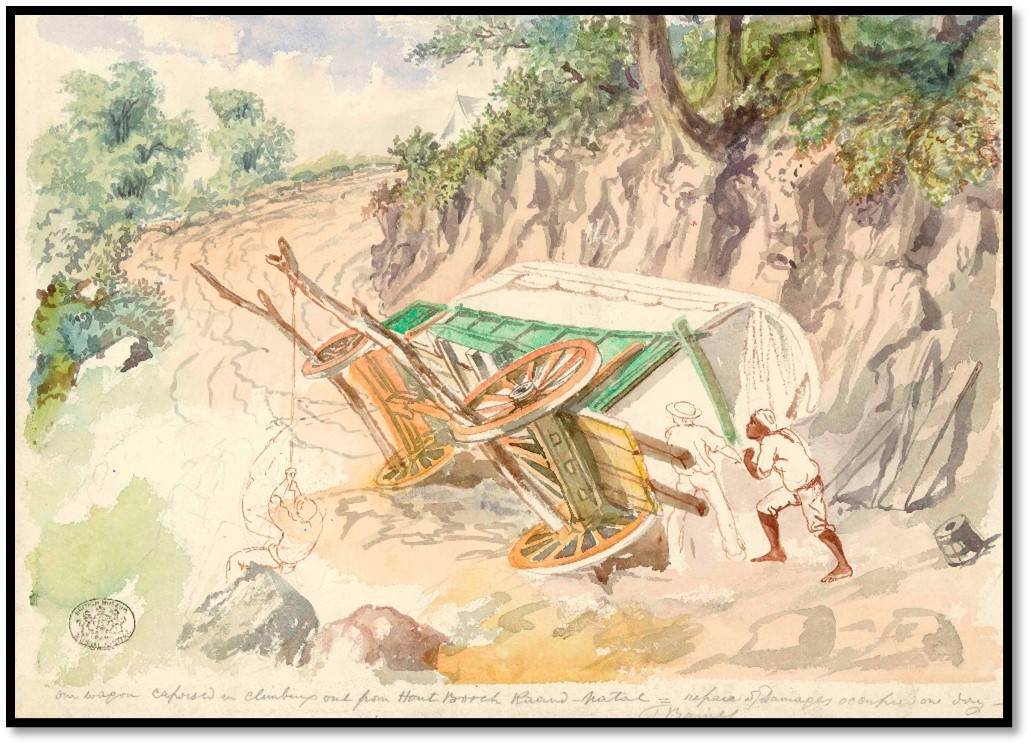
NHM (London) Baines Collection No 2: This March 1869 watercolour shows a capsized wagon being righted back on its wheels
At the confluence of the Pakwe and little Tuli they met a group of Matjen’s men who had already frightened their servants and would have been overbearing if there had been more of them. They said Matjen had dried up all the water in our path “But when we asked whether he had also dried up the Crocodile [Limpopo] River they acknowledged that that was beyond his jurisdiction.” They camped near the wagons so everyone kept an eye on the horses and oxen.
25-Oct Trekked early before halting at Biles’ Pool to fill water casks and cut a log of baobab wood for Kew and other museums. Slept at the Great Tree which Jewell measured at 63 ft.
Latitude 22° 19´ 41" S
26-Oct Reached Wild Duck pool on a tributary of the Pakwe river. Baines writes: “According to the map however we have crossed the Limpopo 10 or 15 miles back.”
27-Oct Gee and Baines followed the wagon spoor south-east for 13½ miles as far as an outspan beside a dense dark line of thorn trees that looked down on the Limpopo river. Here they ate a cake of bread washed down with Limpopo water. Every insect that came near was inspected carefully for tsetse-fly. They were very tired by the time they were back at the wagons having walked for 11 hours.
28-Oct Inspanned at daybreak and in 5 hours reached the hunter’s outspan at the Limpopo. Karel caught a fine barbel for breakfast. Gee found a kraal of Masarwas[vii] who are related to the Khoisan people and speak their language and persuaded them because we are English and not Boers to come to the wagons. Henry Byles agrees to give them powder and lead if they will show us a route clear of the fly.
Latitude 22° 35´ 31" S
29-Oct Baines spent the day mapping. Byles and Jewell shot zeekoes (hippo) and they will see if any float to the surface tomorrow. Baines is feeding the Bush baby on voetgangers (young locusts) that she enjoys…her name is Jeanette.
30-Oct The Masarwas guides came early and took them 4½ miles upstream to a spot where it flows 100 yards wide over a sandy bottom. It was a hard pull for the oxen until they outspanned on the Limpopo’s southern side. The hunters declared it free of tsetse-fly and went out to find meat. Byles shot a Pallah (duiker) and after returning to the wagons saw a fly on Jewell’s hat. The cattle and horses were brought in immediately and Gee recalled. The guide was paid off with a bar of lead and flask of powder. In the afternoon they trekked 5 miles south-west and outspanned near a village.
Their journey continues as the map shows, but this article from Baines’ diary ends here.
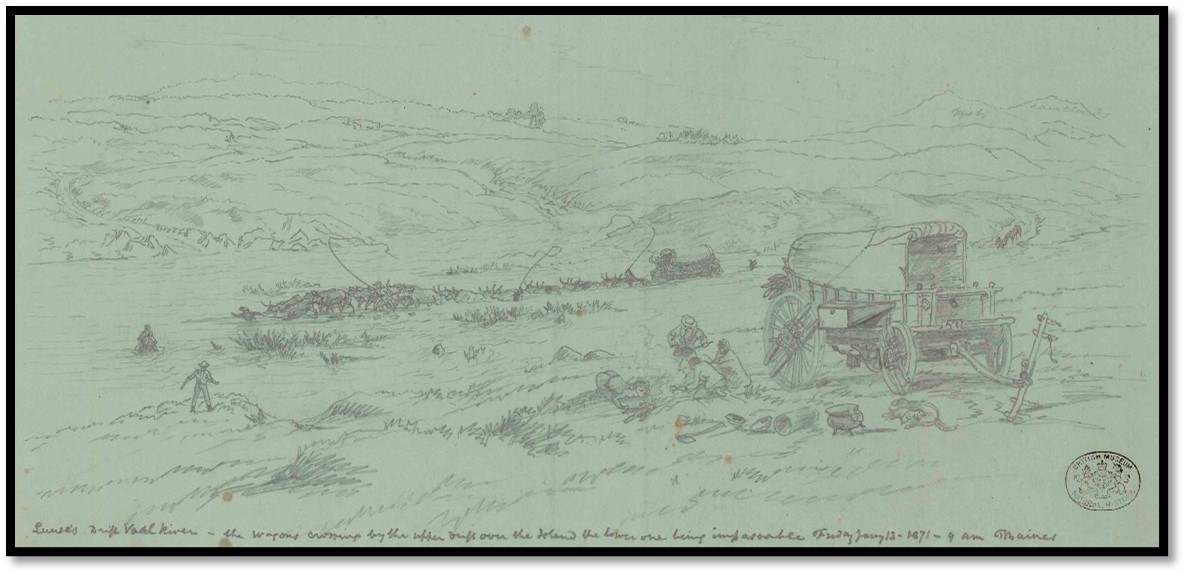
NHM (London) Baines Collection No 57: Wagons crossing Luuse’s drift on the Vaal river
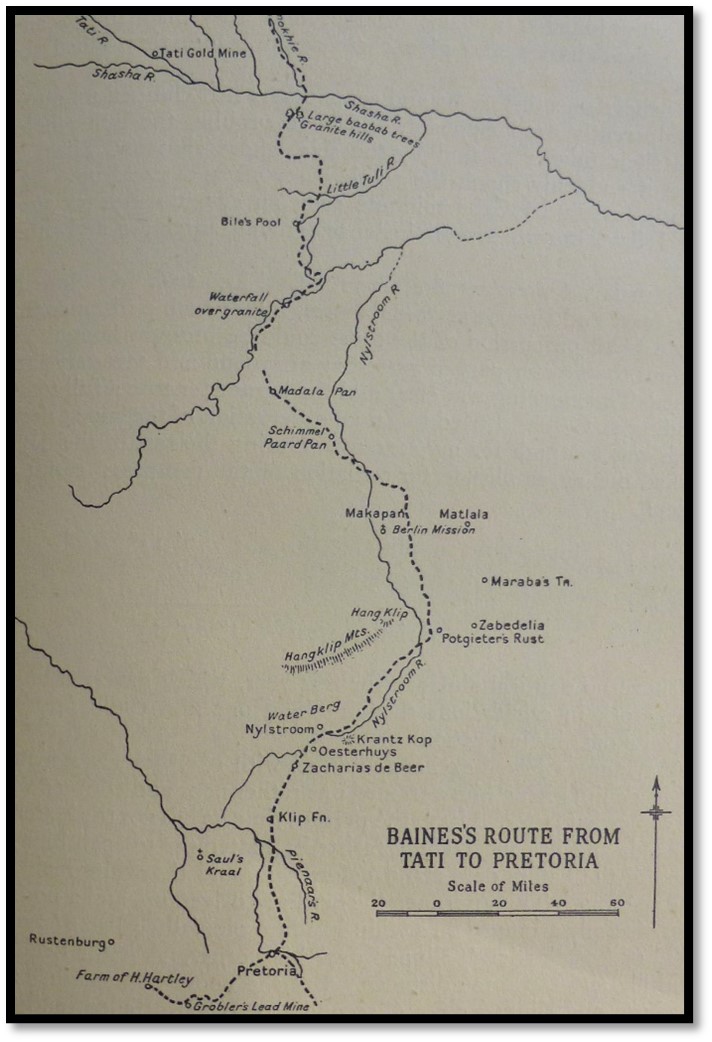
Map from Vol 3 of The Northern Goldfields Diaries of Thomas Baines (1869 – 1872)
References
J.P.R. Wallis (Editor) The Northern Goldfields Diaries of Thomas Baines (1869 – 1972) Volume 3. Chatto and Windus London 1946
J.P.R. Wallis. Thomas Baines of King’s Lynn. Explorer and Artist 1820-1875. Books of Zimbabwe, Bulawayo, 1972
E.C. Tabler. Pioneers of Rhodesia. C. Struik (Pty) Ltd Cape Town, 1966
Natural History Museum (NHM) London for painting and sketch images (https://www.nhm.ac.uk/)
Appendix
Ratification of Grant made verbally by Lo Bengulu, Supreme chief of the Matabili nation, to Mr Thomas Baines on behalf of the South African Goldfields Explorations Company Limited on the 9th day of April 1870.
I, Lo Bengulu,
King of the Matabili nation, do hereby certify that on the 9th day of April 1870, in the presence of Mr. John Lee, acting as agent between myself and Mr Thomas Baines, then and now commanding the expedition of the South African Goldfields Exploration Company Limited, I did freely grant to Mr Baines, on behalf of the above named company, full permission to explore, prospect, and dig or mine for gold in all that country lying between the Gwailo River on the South West and the Ganyana on the North East, and that this my permission includes liberty to build dwelling and store-houses, to erect machinery for crushing rocks or other necessaries and for the removal of the gold so obtained and it also includes all lesser details connected with gold mining.
In making this grant I did not alienate from my Kingdom this or any other portion of it but retained intact the sovereignty of my dominions and Mr Baines engaged on behalf of the said company not to make any claim contrary or injurious to my right as sovereign of the country, but to recognise my authority as King and apply to me for such protection as he might require and I engaged to grant such protection to Mr Baines as should enable him to enjoy all lawful and proper use of the privileges granted him by me. And I also certify that when, in November of the same year 1870, Mr Baines asked me what tribute or payment he should make to me in return for said privileges, I declined to name any sum, but left it to the judgement of Mr Baines to make me annually, on behalf of the said company, such present as might seem proper to him and acceptable to me.
Among the Matabili the verbal promise of the King has always been regarded as a sufficient guarantee and many white men now enjoy privileges in virtue of grants made by my father Umseligazi, which I regard as binding on me.
I also regard my verbal permission given to Mr Baines as valid and binding on me and my successors but finding that the customs of white men require that such grants or promises should be made in writing, I now hereby solemnly and fully confirm the grant verbally made to Mr Baines on behalf of this company.
In witness of which I hereto append my sign manual,
Lo Bengula.
(Signed) His + mark O and seal.
Signed this 29th day of August 1871
Signed same time in witness hereof,
Signed G.A. Phillips
F. Betts
Robert J. Jewell
John Lee.
Notes
[i] Paul Zietsman a hunter and trader appears in Volume 2 when in 1869-70 with his wife and children he started a blacksmith business at Old Tati and also a tannery curing ox hides. In 1870 he went hunting as far as the Ganyana (Hunyani, present-day Manyame river) in Mashonaland, but stopped hunting at the end of 1870.
[ii] Patrick McGillewie did get to Tati in August / September 1871 but does not appear to been to Mashonaland and no memorial to all those buried in lonely graves was erected.
[iii] Harry Grant a hunter and trader built Lobengula’s house at Old Bulawayo. See the article koBulawayo, or Old Bulawayo (1870 – 1881) and the Indaba Tree under Bulawayo on this website
[iv] William Francis Established the firm of Francis and Clarke in Shoshong in 1872; the most successful trading business for ivory and ostrich feathers during the 1870’s with much trade with George Westbeech at Pandamatenga.
[v] See the article koBulawayo, or Old Bulawayo (1870 – 1881) and the Indaba Tree under Bulawayo on this website
[vi] See the article Hope Fountain Mission under Matabeleland South on this website
[vii] Rev S.S. Dornan in his article The Tati Bushmen (Masarwas) and their language in the Journal of the Royal Anthropological Institute of Great Britain and Ireland Vol. 47 (Jan - June 1917) P. 37-112
When to visit:
n/a
Fee:
n/a
Category:
Province:
